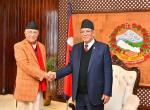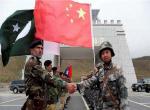The implementation of India-Afghanistan Strategic Partnership, signed more than a year ago, is all set to gather momentum in coming months in the wake of a successful India visit by Afghanistan's President Hamid Karzai earlier this week.
While Karzai, who first flew to Mumbai before coming to New Delhi for more formal discussions with Government leaders, was more focussed on wooing Indian investors, the most concrete outcome of his four-day visit was the finalisation of a detailed training programme for Afghan security forces in Indian training institutions.
Under the pact, which was under discussion for almost a year, India has agreed to train upto 600 Afghan Army officers every year in India. Under the agreement, India, which has the world's third-largest army will train, equip and build the capacity of the Afghan forces.
Sources in the Indian security establishment familiar with the contours of the detailed schedule say Kabul and New Delhi have identified three areas to focus on - increasing the intake of officers in India's premier training institutes; providing specialized training to middle and higher level officers already operating in the Afghan National Army (ANA); and training soldiers in counter-insurgency and counter-terrorist operations.
Over 200 Afghan cadets will be training at the National Defence Academy, the Officers' Training Academies and the Indian Military Academy every year. This is over and above the 600 serving Afghan National Army (ANA) officers who will undergo a variety of courses.
In addition, company level (100-strong) contingents of ANA will be trained for four weeks at the Counter Insurgency and Jungle Warfare School (CIJWS)located at Vairangte in Mizoram.
India however has no plans to send or deploy its troops in Afghanistan as of now.
"India is a great destination for us, for the training of our military, for the training of our police and for the provision of equipment that India can provide, that is, within the means of India. We are certain that proximity that we have, the centuries of civilizational links that we have, makes it easy for Afghan young officers - man or woman - to come to India and get the best from here. That will be a great contribution in bringing the Afghan Army and police to an institutionalized order which is of the highest importance for us," Karzai told Amitabh Revi, my colleague at NDTV in an interview just before departing for Kabul on Tuesday.
New Delhi has also decided to supply vehicles, information technology and sports equipment, a move seen as a paradigm shift in India's approach to Afghanistan.
So far, India has concentrated on using "soft power" in the development sector, such as helping with the building of roads, hospitals and even the parliament building in Afghanistan. But by offering extensive training facilities for ANA, India has decided to ramp up its involvement, although it's currently stopping short of supplying any military hardware. New Delhi has also decided not to send training teams to Afghanistan in view of the two attacks on its embassy in Kabul.
The Indian security and strategic establishment has been wary of discussing the Indo-Afghan military-to-military relationship, not least because of Islamabad's sensitivities. Pakistan sees the growing relationship between New Delhi and Kabul as denying "strategic depth" to its army, and as an Indian attempt to encircle Pakistan.India has been central to Afghanistan’s quest to rebuild its economy. Since 2002, India has contributed over 2 billion dollars in aid.
In the last week of June this year, New Delhi had hosted an investors conference that focused on inviting companies and businessmen to invest in Afghanistan. It was a first for New Delhi.
At the investors conference those thoughts appeared far from everyone’s mind. Organized jointly by India’s External Affairs Ministry and the Confederation of Indian Industry (CII), the conference attracted private investors from over 40 countries. The Afghans were also present in strength. Five senior ministers handling mining, commerce and finance were in attendance. And they went out of their way to assure potential investors. As Anwar-ul-Haq Ahady, Afghanistan’s commerce minister said: “When you take into account the high level of risk, the return on investing in Afghanistan is much greater than most other parts of the world … Your investment will not only benefit you and your employees but also create conditions that will promote peace and stability in Afghanistan and the wider region.”
Although it’s early days yet to judge if the Delhi conference resulted in any substantial commitments from private companies, CII and Afghanistan officials are hoping that the companies would have gotten a fair idea about business opportunities that exist in the war-ravaged country.
That time Afghan officials listed several measures to woo investors. They said the government had adopted an investor-friendly foreign-exchange system and allowed banks to open foreign-exchange accounts. “We have also permitted 100 per cent foreign ownership of enterprises and easy repatriation of profits,” one official said.
India’s foreign minister S.M. Krishna pointed out what lies ahead. “We visualize Afghanistan's mineral resources, agricultural products and human resources as possible drivers of growth and regional economic development that together with the energy resources of Central Asia, Iran and the Gulf, the growing economic prowess and markets of China, Russia, Turkey and India, could knit the entire region between Turkey in the west, Russia in the north, China in the east, and the Arabian Sea and the Indian Ocean in the south, in a web of trade, transit and energy routes and economic cooperation. This vision requires international support in the form of institutional finance and foreign investment,” he told the conference participants.
This time too, Karzai's delegation was more forthcoming on allowing India and Indian companies to mine Afghanistan's vast natural resources. Indian companies are planning to invest over 11 bn dollars in the mining sector over the long term in Afghanistan.
The Afghan President however admitted that the security situation is still fragile and attacks by Taliban would continue post 2014, but there was no chance of the Taliban grabbing power again.
"I don't visualise that happening because Afghanistan has advanced... revolutionised massively. There are, as I said, thousands and thousands of Afghans youth who have returned from education abroad and there are tens of thousands who are educating themselves in south Afghanistan. These big cities of Afghanistan has transformed like never before. We have built more roads and more reconstruction and development has taken place in Afghanistan, in the past 10 years, in the whole of our history. So, an obscurantist mindset's return to Afghanistan to take power is absolutely a thing of the past and will not happen. Hence, a sense of insecurity will still continue. There will be bomb blasts, there will be incidents like that, that we have in our whole region. But that will not be a hindrance to the progress of Afghanistan or to the continuation of the democratic rule in Afghanistan," Karzai said.
Karzai also met Prime Minister Manmohan Singh. The two leaders also reviewed progress in the implementation of the Strategic Partnership Agreement during the past year.The Indian government also cleared another tranche of development aid to the tune of Rs. 540 crore to be given to the war-torn country where such help has earlier directly benefited the local communities.
Published Date: 17th November 2012








Post new comment